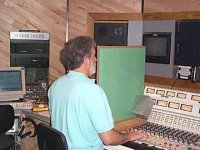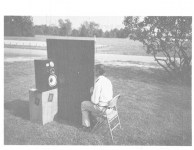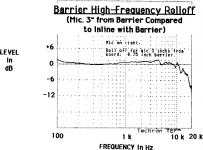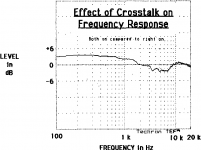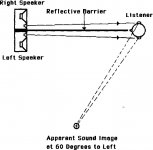I guess it's reasonable, although a bit more "head in a vise" than having all the speakers at the other end of the room. The delay requirement for it to work is pesky; unsure how to do it with the digital class D amplifiers I'm using. I once had the thought if one could digitally delay all three signals of a I2S connection by the same number of ms; the amplifier output would then be delayed by the same time.
There's a chip that does such a straight time delay of a digital signal, I'm sure.
My Zoudio amps (TAS5825 based) do have some delay that the amp chip offers, however it's in inches of time, versus feet.
Thanks for your reply and sharing! Interesting idea, if you can come up with the bits to get it to work. I didnt know Polk has a current redo of their old SDA technology. I'm currently playing with that on my own; but I'll start my own thread soon.
There's a chip that does such a straight time delay of a digital signal, I'm sure.
My Zoudio amps (TAS5825 based) do have some delay that the amp chip offers, however it's in inches of time, versus feet.
Thanks for your reply and sharing! Interesting idea, if you can come up with the bits to get it to work. I didnt know Polk has a current redo of their old SDA technology. I'm currently playing with that on my own; but I'll start my own thread soon.
Why would you need four channels for Ambio?
I've done it various ways, and a plain ol' barrier works pretty darn well. I've done two different setups using a barrier, over the past year or so, and my current set up uses a barrier. I'm just using a sheet of plywood that's covered in Bubos Acoustic Panels.
About seven years ago I (accidentally) stumbled upon a way to do something that's similar to Ambio, but sounded superior IMHO. I can describe how I did it you'd like. I ended up trashing the project because it made everything sound TOO big. The soundstage was distractingly huge.
for 4 speakers . .
here's my ambio setup
The barrier separates a pair of JBL center channel speakers. The JBL speakers are particularly directional on the horizontal axis
I covered the barrier in Bubos sound absorbers (I still need to buy more.)
On my previous setup I had the barrier go nearly all the way down to my desk. You'd think it would be distracting, but surprisingly it's not, especially if you sit exactly equidistant.
It's interesting how the sound stage gets better and better as it gets closer to your face; a gap of even two or three inches is audibly worse than having it come all the way to my face.
Another option that might be worth a look is to apply a little bit of ambio processing (but not a lot.) I find that the electronic processing can sound kinda weird so use it sparingly.
I listen to a lot of podcasts, and for that the ambio setup simply sounds like mono.
Interesting approach!
$80 MiniDSP and you're good to go 🙂
If you go with the MiniDSP HD you can also flatten out the phase.
It would definetely be good to flatten the phase
This model? https://www.minidsp.com/products/minidsp-in-a-box/minidsp-2x4
I know it is inconvenient, but a foam barrier worked wonders.
The thing on the software (to me), it can prevent the initial left right ear thing, but to me it cannot defeat the right speaker sound bouncing off the left wall then going into your left ear........
But software driven nearfield (maybe less than 4') it should work really well.
the picture below is an old one, barrier, no software.
When I did a big long barrier, down the middle of the room, the voices were locked and solid in the middle 10' away.
Knock down the barrier, the center image seemed 6db down 3' wide hazy hazy blob.
But, obviously, the giant barrier was an utter pita, and forget watching movies also..............
The thing on the software (to me), it can prevent the initial left right ear thing, but to me it cannot defeat the right speaker sound bouncing off the left wall then going into your left ear........
But software driven nearfield (maybe less than 4') it should work really well.
the picture below is an old one, barrier, no software.
When I did a big long barrier, down the middle of the room, the voices were locked and solid in the middle 10' away.
Knock down the barrier, the center image seemed 6db down 3' wide hazy hazy blob.
But, obviously, the giant barrier was an utter pita, and forget watching movies also..............
Attachments
What intrigues me is I found the graphs roughly backing up what I heard.
With baffle 10' away, the image size (with the barrier), voices were as point source as someone talking.
But good luck with the barrier, no juke-box awesome sound everywhere, no flopping on the couch, and no having tunes while playing vids or poking around the internet on your tablet...................
With baffle 10' away, the image size (with the barrier), voices were as point source as someone talking.
But good luck with the barrier, no juke-box awesome sound everywhere, no flopping on the couch, and no having tunes while playing vids or poking around the internet on your tablet...................
I've played with this method too. Huge sound field but I could never get it to sound "clean." The divider wall is much purer sounding to my ears than anything that tries to use extra speakers to augment the normal 2 channel arrangement. Lately I've been playing with the simple 3 speaker array matrixed with L-R, L+R, and R-L. The key to this is getting the speakers all fairly close together and in a straight row, and setting yourself an appropriate distance back from the 3 speakers. I find this to provide close to 180 spread on content that does that sort of thing, while still sounding very pure and natural, actually cleaner than 2 channel stereo, which it should. I think this is because for center panned sounds only the center speaker plays. There's not always multiple sound sources that need to be precisely time aligned at your ears so you don't get a bunch of inadvertent comb filtering. I like the way it sounds almost as much as a divider wall. A more advanced version uses a wider spaced set of speakers for the lower frequencies. I tried this at work in a big room we have and it's something new to me to hear excellent imaging maintained as I get further and further back from the speakers. The imaging stays similar but the room tone becomes more obvious. The room reflections are heard affecting the tone but they're not strong enough to upset the imaging. Once I reach the back wall I hear the bass being reinforced and again it seems to be projected on to the entire perceptual sound field, which remains relatively undisturbed by room reflections.OK, so I came up with this accidentally:
A few years back, I was reading about a Bose system that was created for Cadillac. The Bose press release hinted that the system would have noise canceling.
In headphones, the way that noise canceling works is that it records the ambient noise and then simultaneously plays back an inverted version, canceling the noise.
I speculated that someone could achieve something similar without microphones by AUGMENTING what the speakers are playing.

In other words: here's the stereo triangle. What if we ADDED some speakers near the listener, to AUGMENT the sound that's radiated from the loudspeaker itself?
That's an eeenteresting idea!I've played with this method too. Huge sound field but I could never get it to sound "clean." The divider wall is much purer sounding to my ears than anything that tries to use extra speakers to augment the normal 2 channel arrangement. Lately I've been playing with the simple 3 speaker array matrixed with L-R, L+R, and R-L. The key to this is getting the speakers all fairly close together and in a straight row, and setting yourself an appropriate distance back from the 3 speakers. I find this to provide close to 180 spread on content that does that sort of thing, while still sounding very pure and natural, actually cleaner than 2 channel stereo, which it should. I think this is because for center panned sounds only the center speaker plays. There's not always multiple sound sources that need to be precisely time aligned at your ears so you don't get a bunch of inadvertent comb filtering. I like the way it sounds almost as much as a divider wall. A more advanced version uses a wider spaced set of speakers for the lower frequencies. I tried this at work in a big room we have and it's something new to me to hear excellent imaging maintained as I get further and further back from the speakers. The imaging stays similar but the room tone becomes more obvious. The room reflections are heard affecting the tone but they're not strong enough to upset the imaging. Once I reach the back wall I hear the bass being reinforced and again it seems to be projected on to the entire perceptual sound field, which remains relatively undisturbed by room reflections.
All of YouTube is going nuts over this new speaker.
https://us.soundcore.com/products/motion-x600-a3130011
I'm like people, we've been talking about this for decades!
https://us.soundcore.com/products/motion-x600-a3130011
I'm like people, we've been talking about this for decades!
" Immersive Spatial Audio: Inspired by theater acoustics, Motion X600 features an upward-firing full-range driver on top, combined with 2 woofers and 2 tweeters on each side to deliver sound all around you."
https://www.soundcore.com/products/...x6&utm_medium=affiliate&utm_source=shareasale
Last edited:
If I buy one of these will that young woman in the picture come over and sit on my couch with me?
That is the, uh, implication. $200 is cheap versus no chance. Unsure what impression $200 in DIY would give these days. Even if you could do better sound wise, the box is pretty slick looking. According to the imagery, she'd think you're pretty slick for having it!If I buy one of these will that young woman in the picture come over and sit on my couch with me?
Lately I've been playing with simple stereo and a really wide listening triangle. This works surprisingly well for me, and gives a phantom center tone brightness that I like compared to the typical 60 degree triangle.
Over the last few days I did an experiment in my room where I used 2' x 4' panels placed on the walls at angles to redirect the early reflection sound away from me and back toward the speaker of origin, including across the room reflections that go across the head from the wrong direction. I was surprised at how much this added to the stereo effect, coming close to what I hear with a physical barrier up to the face, or digital XTC.
My concern was mostly with the cross room reflections, which add to inter-aural crosstalk. How much effect do these reflections have on our stereo perception compared to the direct sound from the speakers? It seems quite a lot. So even if you don't run a barrier right up to your face, just keeping reflections from the left and right speaker mostly coming from their corresponding side of the room seems to have a significant effect with helping your brain to sort out the initial crosstalk. A big physical barrier goes a long ways to keeping the left and right sound mostly on the correct side of the room, so that may be one big reason I've preferred it so far over other methods.
Over the last few days I did an experiment in my room where I used 2' x 4' panels placed on the walls at angles to redirect the early reflection sound away from me and back toward the speaker of origin, including across the room reflections that go across the head from the wrong direction. I was surprised at how much this added to the stereo effect, coming close to what I hear with a physical barrier up to the face, or digital XTC.
My concern was mostly with the cross room reflections, which add to inter-aural crosstalk. How much effect do these reflections have on our stereo perception compared to the direct sound from the speakers? It seems quite a lot. So even if you don't run a barrier right up to your face, just keeping reflections from the left and right speaker mostly coming from their corresponding side of the room seems to have a significant effect with helping your brain to sort out the initial crosstalk. A big physical barrier goes a long ways to keeping the left and right sound mostly on the correct side of the room, so that may be one big reason I've preferred it so far over other methods.
Could you add a drawing please? How are the speakers toed-in and placed relative to walls corners etc.? I've confirmed that a center-line barrier helped a lot in a very tight space, and that speakers could be fired directly toward walls or reflector boards for stereo.Over the last few days I did an experiment in my room where I used 2' x 4' panels placed on the walls at angles to redirect the early reflection sound away from me and back toward the speaker of origin, including across the room reflections that go across the head from the wrong direction. I was surprised at how much this added to the stereo effect, coming close to what I hear with a physical barrier up to the face, or digital XTC.
Here's a basic render. The speakers are actually toed-in about 45 degrees and in the corners. They're big corner horns so pretty directional so I'm not treating for the reflections directly adjacent to the speakers. Those panels that are close to each speaker are actually for the opposite speaker's first reflection on the side wall. The panels flanking my chair are most important.Could you add a drawing please? How are the speakers toed-in and placed relative to walls corners etc.? I've confirmed that a center-line barrier helped a lot in a very tight space, and that speakers could be fired directly toward walls or reflector boards for stereo.
I just set it back up and discovered that it's important to get the panels positioned accurately to make sure the paths from the first reflection points on the walls are actually getting blocked and redirected. Somehow on this 2nd setup I'm not seeming to get as strong an effect. Maybe it's just my ears tonight but some of the sound wrapping around me doesn't seem to be happening this time to quite such an extent.
Edit: I just discovered the secret sauce I forgot about - got to catch the ceiling reflection too! There's one straight back to the wall, but also one that goes up to the ceiliing, back down to the wall, and then back down to my head, which means it bypasses the panels sitting on the floor.
Last edited:
https://www.whatsbestforum.com/threads/help-with-floor-bounce-diffuser.32083/
Here is a floor bounce destroyer.

Here is a floor bounce destroyer.
Nice! My tweeter is closer to the ceiling than the floor, for better or worse. That thing looks like it could get after a wide range of frequencies.Here is a floor bounce destroyer.
- Home
- Loudspeakers
- Multi-Way
- Try Ambiophonics with your speakers
